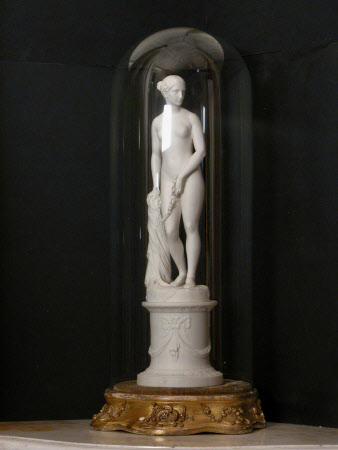A Minton Parian ware figure of 'The Greek Slave'
Minton's Ltd (Minton and Co.)
Category
Ceramics
Date
1848
Materials
Parian porcelain, giltwood base and glass dome
Measurements
(15 in) 382 mm (Height)
Place of origin
Stoke-on-Trent
Order this imageCollection
Arlington Court, Devon
NT 985340.1
Summary
A Parian ware figure of 'The Greek Slave' by Minton, 1848. The figure is standing on a ceramic pedestal, which is resting on a giltwood base and is covered by a glass dome. A standing naked figure of a woman, looking to her left, her right hand resting on a support, around which is wound a fringed cloth. A chain runs between the hands.
Full description
‘The Greek Slave’ is a porcelain copy of a well-known marble sculpture of the same name by the American sculptor, Hiram Powers (1805-1873). Created in Florence in 1843, 'The Greek Slave' was toured around American cities between 1847 and 1849 and was exhibited in London in 1845 and 1848. It was also the centrepiece of the United States display at the Great Exhibition in Hyde Park in 1851, where large crowds were drawn to see the full-length female nude figure and admired its modern interpretation of classical forms. Powers stated that his sculpture represented a Christian who was captured during the Greek War of Independence against the Ottoman Empire (1821-32) and placed for sale in the market in Istanbul (then Constantinople). The sculpture was, however, also seen as a commentary on contemporary slavery and became a potent symbol for the abolitionist movement. The popular appeal of the sculpture led to a commercial response, in the form of cheaper reproductions in materials such as plaster, alabaster (see NT 1139597) and bronze. Parian ware is a type of unglazed porcelain, which was first developed by companies such as Minton and Copeland in the 1840s. Resembling marble from the island of Paros and with sculptural qualities, Parian was particularly suited for making reproductions of famous works of art. Between c.1846 and 1910, Minton produced over 500 different designs for Parian figures and issued the first version of ‘The Greek Slave’ in 1848. The V&A and The Metropolitan Museum in New York hold examples of this Minton Parian ware figure in their collections.
Credit line
Arlington Court, The Chichester Collection (National Trust)
Makers and roles
Minton's Ltd (Minton and Co.) , ceramic manufacturer after Hiram Powers (Woodstock, Vermont 1805-Florence 1873), sculptor
Exhibition history
Sculpture Victorious: Art in an Age of Invention, 1837–1901, Yale Center for British Art, Connecticut, 2014 - 2015 Sculpture Victorious: Art in an Age of Invention, 1837–1901, Tate Britain, London, 2014 - 2015
References
Read 1982: Benedict Read, Victorian Sculpture, New Haven and London, 1982, pl. 27 Sculpture Victorious Art in an Age of Invention, 1837 – 1901, exh. cat., Yale Center for British Art, September 11, 2014 – November 30, 2014 and Tate Britain, 25 February – 25 May 2015, cat. no. 82 James, Henry,. William Wetmore Story and his friends. 1903, p. 114-15
